Birmingham and Aston Tramways
History
The Birmingham and Aston Tramways Company began steam-operated tramway services on the 26th December 1882. This small, 4.85-mile, 3ft 6ins-gauge system consisted of a line northwards from Ashton Street in Birmingham to Aston Cross, where the line split into two, both lines going to Witton; these were later supplemented by a branch line northeastwards to the bottom of Gravelly Hill, which opened in 1885. The company owned the lines outside Birmingham (within the Urban District of Aston Manor), but operated those within Birmingham under a lease arrangement with Birmingham Corporation. The latter had decided relatively early on to control all tramway development within its boundaries, which it did by building its own lines and leasing them to tramway operators; although the first of these were standard gauge, the Birmingham and Aston route was built to a narrower gauge of 3ft 6in, as were all subsequent Birmingham and Black Country tramway lines.
The Birmingham and Aston Tramways Company operated the system very successfully for twenty years, before the company sold out to Aston Manor Urban District Council; although the official date of acquisition was the 1st July 1902, the operational handover did not take place until the 25th March 1903, the year that Aston Manor was elevated to borough status. Aston Manor UDC/Corporation operated steam services over its own, as well as Birmingham's tracks (as the lessee), until the 1st of January 1904, when it leased operation to the City of Birmingham Tramways Company for a period of twenty-one years. It is unclear whether the CofBTCo took over operation of the section within Birmingham, as the lease expired only two days later, Birmingham Corporation introducing its first electric services on that section on the 4th January 1902. The CofBTCo continued to work the lines within Aston Manor UDC with steam traction, though this was gradually replaced as the system was converted to electric traction; the last steam tram running on the 13th November 1904. The CofBTCo's last electric services in Aston Manor ran on the 31st December 1911, Birmingham Corporation taking over the following day.
Uniforms
In common with the majority of UK steam-operated tramways, drivers wore very similar attire to their railway counterparts, namely, heavy-duty trousers and jackets, often cotton and light in colour, along with soft-topped or flat caps. No badges or insignia were worn on either the jackets or the caps.
Conductors appear to have worn informal attire, though often with a soft-topped cap, which in all probability was self-purchased from a local supplier, giving a certain consistency in appearance, though not at the company's expense of course. These caps were devoid of insignia, as were the flat caps that increasingly made an appearance prior to conversion to electric traction.
Conductors also wore a round, brass, municipal licence; this bore a number and a grade ('CONDUCTOR'), above which were the arms of Birmingham. There are two types of licence, which almost certainly reflect the situation prior to, and after, the full grant of arms to the city in April 1889 (see below).
Photographs of tramcar crews taken during the nine-month period when Aston Manor UDC/Corporation operated the tramway, appear not to have survived, so it is not possible to say what attire tramcar crews wore. In all likelihood, however, the Council/Corporation very probably continued the policy of its predecessor in not issuing uniforms.
A superb studio portrait of a B&ATCo inspector has recently come to light, which although undated, it is likely to have been taken in the 1890s. The subject is wearing a three-quarter length. single-breasted jacket with six metal buttons, and with his grade — 'Inspector' — in script lettering on the stand-up collars; it is unclear whether the collar badges were metal or embroidered. His kepi-style cap clearly bears metal badges, a script-lettering grade badge above the individual company initials, 'B & A T Co'.
Further reading
For more information on the Birmingham and Aston Tramways, see: 'A History of the British Steam Tram — Volumes 1 and 2' by David Gladwin; Adam Gordon Publishing (2004 and 2006). For a history of Birmingham's tramways, see: 'A Short Review of Birmingham Corporation Tramways' by P L Hardy and P Jaques; H J Publications (1971).
Images
Steam tram drivers and conductors
A rather pristine looking Steam Tram No 13, a Kitson product, suggesting that the photo was taken in January 1885 when this engine was delivered. The engine is standing at the junction of Park Road and Church Lane in Aston. Both men in the shot are wearing railway-footplate like attire. Photo courtesy of the National Tramway Museum.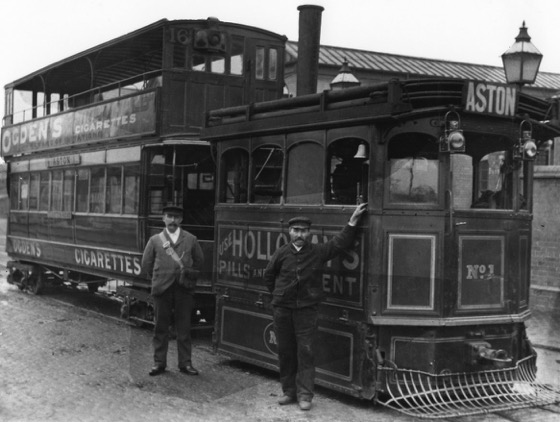
A driver and a conductor pose for the cameraman outside what would appear to be a favoured photographic location, Witton Depot. Although the photograph is undated, the fact that the engine (a Kitson product of 1882) would appear to be in good condition, suggests that it was probably taken after 1897 when it was given a new boiler. Author's Collection.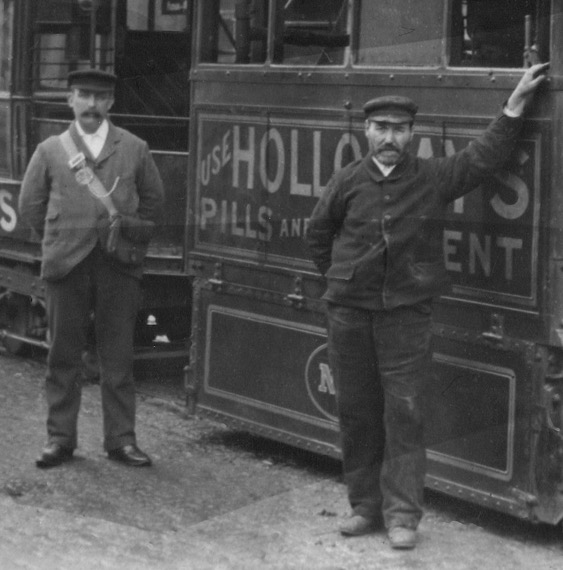
An enlargement of the above photograph showing the crew. The conductor is wearing smart, informal attire and a soft-topped cap, whilst the driver has a heavier jacket, again with a soft-topped cap; neither the jackets nor the caps bear insignia. The conductor has a round licence attached to his cash-bag strap.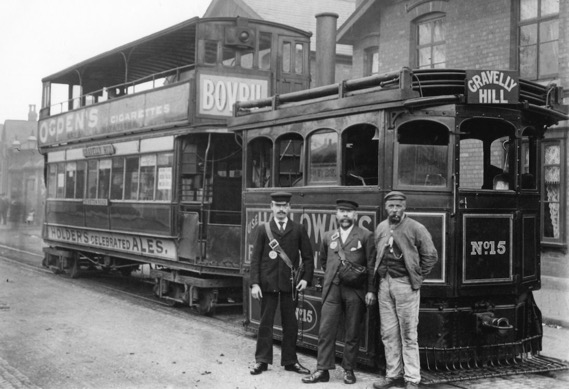
Another shot taken at Witton, this time of Steam Tram No 15, another Kitson that made its first appearance in 1885. The date is thought to be 1900. Author's Collection.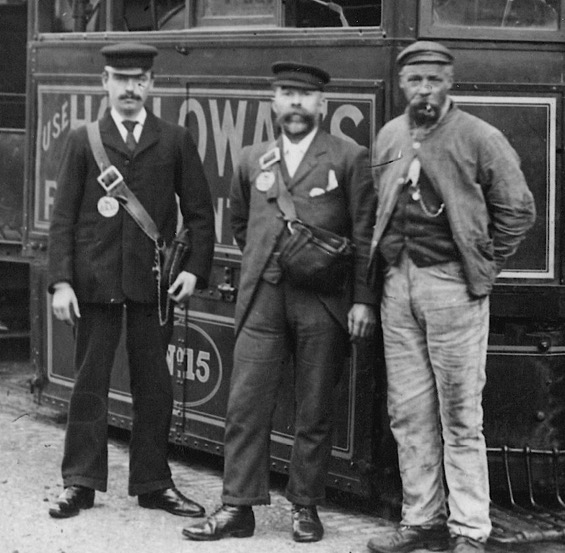
An enlargement of the above photograph showing the tramway men, two conductors and a driver. Once again, the conductors are wearing soft-topped caps, devoid of insignia. Magnification reveals the two licences, both hanging from cash-bag straps, to be the second pattern shown below.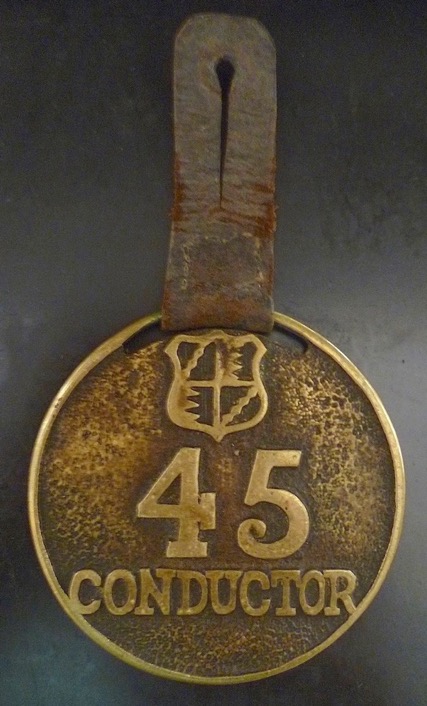
Birmingham municipal licence badge — brass — of the type that was probably issued to B&ATCo conductors prior to 1889. In April 1889. a full grant of arms was made to the city, including supporters and crest, after which the licences were updated. Author's Collection.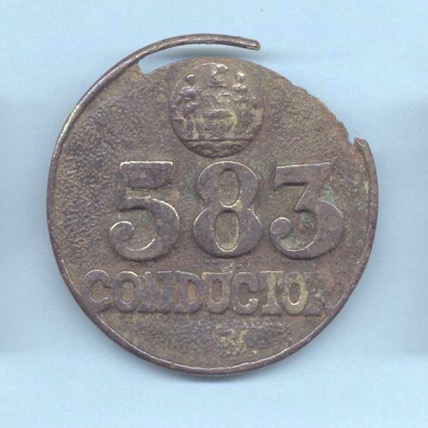
Birmingham municipal licence badge — brass — of the type that was probably issued to B&ATCo conductors from 1889 onwards, following the full grant of arms to the city.
Birmingham municipal licence badges, pre-1889 (top) and 1889 onwards (bottom) — brass. This oval pattern of licence badge may well have been used at some point, though photographic evidence for this is completely lacking. Author's Collection.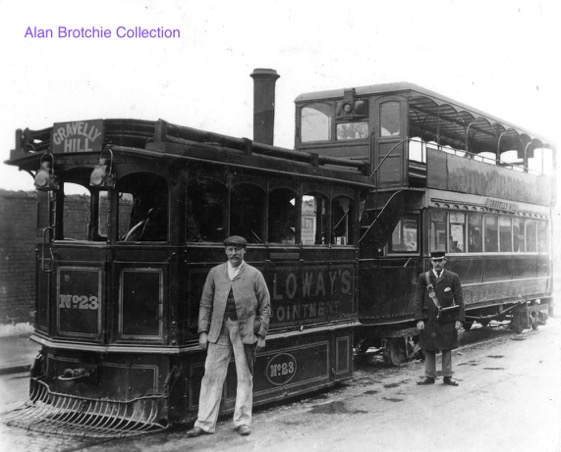
Kitson Steam Tram No 23, delivered in 1886, and an unidentified trailer. Although the photo is undated, the condition of the engine suggests that it was taken shortly after it received a new boiler in 1901.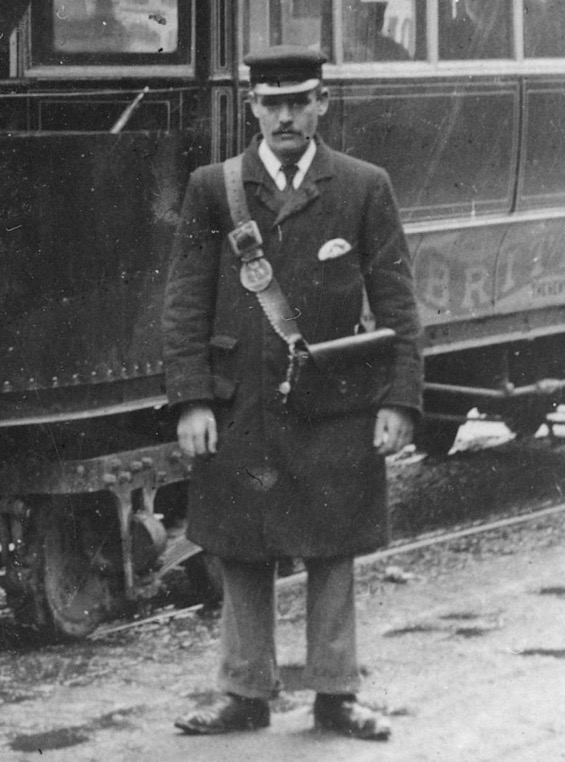
An enlargement of the above photograph showing the conductor. Once again, he is wearing a soft-topped peaked cap, probably self-purchased, perhaps via the company, along with a round licence badge (probably 'No 29 CONDUCTOR') on his cash-bag strap.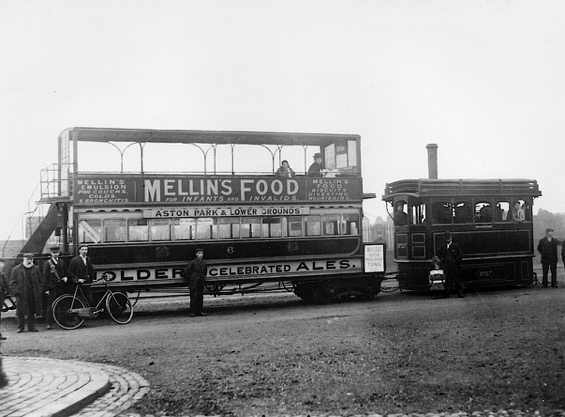
Kitson Steam Tram No 27, which was delivered new in 1886, and Trailer No 6 — photo undated, but almost certainly taken between 1899 (when No 6 was built) and 1902 (when the B&ATCo was taken over by Aston Manor UDC). Photo courtesy of the Tramways and Light Railway Society, with thanks to David Voice.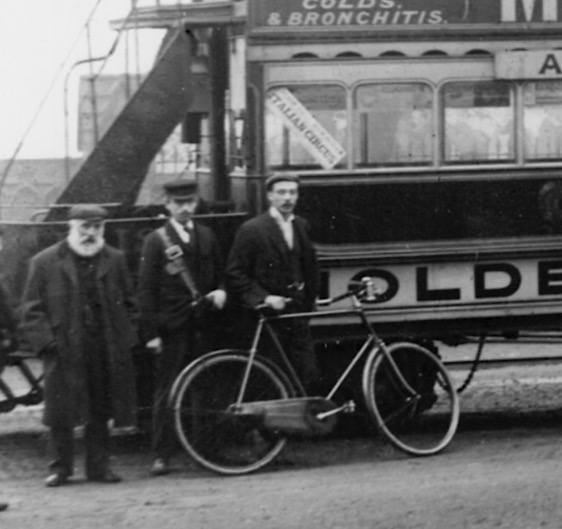
An enlargement of the above photograph showing the conductor; he is wearing the usual cap and licence.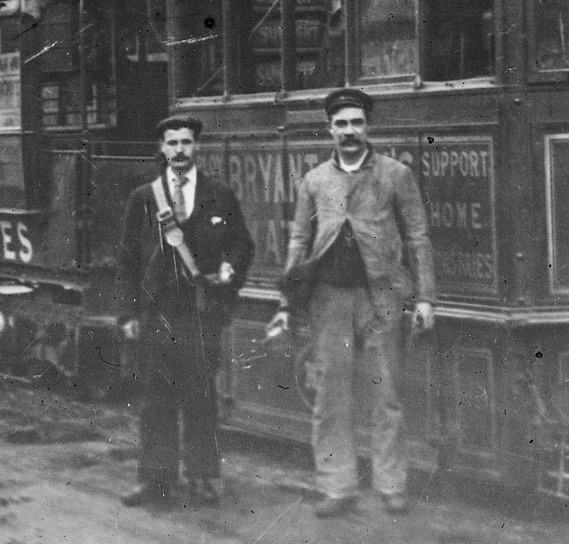
A conductor and a driver pose for the camera with Aston-bound Kitson-built Steam Tram No 19 outside Witton Depot — photo purportedly taken in 1900. The conductor is in informal attire with a flat cap, though he does have a Birmingham municipal licence badge hanging from his cash-bag strap. Photo courtesy of the National Tramway Museum.
Senior staff
A very rare studio portrait of a Birmingham and Aston Tramways Company inspector, taken in the studios of James Fletcher, Lichfield Road, Aston — photo undated, but probably taken in the 1890s. The subject is wearing a three-quarter length jacket with metal buttons, seemingly unmarked, and a kepi-style cap. Photo courtesy of the Helena Cowell Collection.
An enlargement of the above photograph showing details of the collar and cap insignia. The cap badges are definitely metal — the grade above the tramway company initials — though the situation with the grade badges on the collars is less clear, as they could well be embroidered.